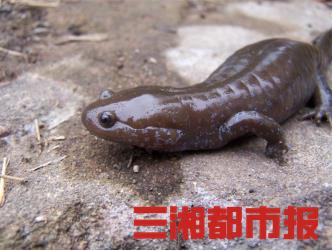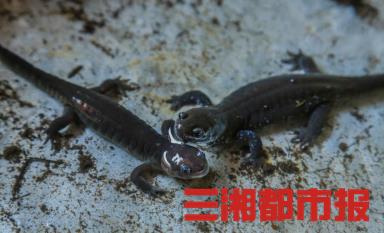
Text/Video Huasheng Online All Media Reporter Tian Tian Trainee Reporter Zeng Guanlin Intern Zheng Tingjie
Appearing in the Jurassic period and at the same time as dinosaurs, the hynobius guabangshan is a "relic animal" more than 300 million years ago, and enjoys the title of "living fossil" of amphibians. A unique and special species, the world is only found in the Qishan Mountains in Yongzhou, Hunan Province.
In 2002, Hynobius guabangshan was first discovered in Hunan and identified as a new species. Its discovery is of great value to the study of animal evolution and human origin, as well as the ecological environment of ancient animals. Small and exquisite, the giant salamander is very demanding on the environment, and its distribution area is quite narrow, which is on the verge of extinction. In 2021, it was listed in the national first-class protected wildlife list. Over the years, researchers have devoted a lot of efforts to the protection of the giant salamander, and now, they have successfully broken through the technical difficulties of artificial incubation.
On September 7th, "Where are the Magical Creatures" aimed at the "living fossil" that belongs to Hunan alone-the giant salamander hanging on the mountain.

Ancient and mysterious, it is an "elf" that belongs to Qishan alone.
In September, Guabang Mountain in Yongzhou, Hunan Province is even cooler, with continuous mountains, dangerous peaks and beautiful scenery. The small and ugly giant salamander is a veritable "baby" in the reserve and has many fans. Wu Chunchun, director of the office of Guabangshan Forest Farm, is one of them. As a protector and a person who has seen the giant salamander in Guabangshan with her own eyes, she especially cherishes this elf.
According to Wu Chunchun, Hynobius guabangshan is a special species of Hynobius, a rare and endangered amphibian relic once contemporary with dinosaurs, with ancient and mysterious characteristics. It is a rare group preserved after the Quaternary Glacier, and Guabang Forest Farm in Qiyang, Yongzhou is its only home.
"It was first discovered in 2022." Wu Chuntian told reporters that in November 2002, Jiang Tianmin, secretary of Longtang Village Branch of Guabang Forest Farm in Qiyang, collected a batch of adult tailed amphibians while working in the forest. Jiang Tianmin consciously recognized many animals and plants, but the amphibians in front of him looked strange and realized that they might be new species. He immediately sent them to the School of Life Sciences of Hunan Normal University for identification. After measurement and microscopic examination by relevant experts, it was initially identified as "Hynobius of Hynobius family".
Subsequently, Professor Deng Xuejian of Hunan Normal University took the lead in organizing an investigation team to make a special trip to Guabang Mountain. It was found that the giant salamander in Guabang Mountain in Qiyang has the characteristics of large area distribution, large population and strong species vitality, which is of great scientific research and protection value. Moreover, it is only distributed in Qishan area, and Qingfengling work area of forest farm is the core distribution area of hynobius guabangshan. Because the giant salamander is very demanding on the environment, its distribution is quite narrow and it is on the verge of extinction.
Wu Chuntian introduced that the giant salamander Guabang Mountain, also known as the giant salamander Qiyang, has an oval and slightly flat head. When living, the back is black or dark brown, and it is slightly yellow-green, waxy and non-striped under the sunlight. Four feet, the adult body length is 80 to 155 mm and the weight is about 80 to 150 grams.
"Many people who have seen it say that it looks a bit like a miniature giant salamander." However, the small and exquisite giant salamander is just "cute and cute" in appearance, but it is actually a malicious character that is not easy to provoke. As a carnivore, it hunts fiercely and is good at finding and preying on insects, earthworms and small arthropods with its forelimbs. You can stop eating for a few days once you are full, and your appetite is huge.
The giant salamander is very picky about the environment and it is difficult to hatch artificially.
Wu Chunchun has been working in the forest farm since he graduated from university in 1997. He first met the giant salamander Guabangshan in 2004, and has been engaged in the protection of giant salamander for 18 years. He knows its habits like the back of his hand.
"The giant salamanders in Guabang Mountain are mostly active in cool and humid places of shrubs, streams and ponds. More timid, it is difficult to find traces in places where human activities are frequent. " Wu Chunchun introduced that only from November to February every year can the giant salamander be seen in the wild when it lays eggs. The giant salamander is afraid of heat and likes temperature. When the weather is hot, it has less activities during the day, while it has more activities during the day in winter.
In recent years, the number of hynobius guabangshan in the wild has obviously decreased due to various external factors. In February, 2021, hynobius guabangshan was listed in the national first-class protected wildlife list. In order to strengthen the protection work, Guabang Forest Farm has taken a series of measures. Wu Chunchun introduced that in the past few years, the forest farm has been doing the propaganda of science and education and the management of infrastructure construction. Next, it will carry out the restoration of ecological wetlands in the reserve, ensure the ecological environment on which the giant salamander depends, and maintain the continuity and development of the giant salamander species.
In addition to the ecological protection and restoration of the habitat of hynobius in Guabang Mountain, researchers have been conducting artificial cultivation research. Hynobius guabangshan grows and breeds in a specific environment, and fertilized eggs are very sensitive to the water temperature of life. When the larvae open their mouths to eat food, if there is no suitable and sufficient food, they will devour each other, which brings great difficulties to artificial cultivation.
Fortunately, a breakthrough has been made in this problem. When Xi Shaoming, a teacher from No.1 Middle School in Qiyang City, carried out research activities in 2015, he learned about the current situation of the giant salamander in Guabang Mountain and began related research. On July 14th, 2021, under the guidance of Professor Deng Xuejian and Professor Liang Zhuming of Hunan Normal University, Xi Shaoming released three giant salamanders cultivated in Bangbang Mountain into the stream of Qingfengling Management Station in Qiyang provincial nature reserve, Hunan Province.
"The journey is still far away, and I will always adhere to the forefront of the protection of the giant salamander in the future." After working in Guabangshan for more than 20 years, Wu Chuntian’s roots have been deeply rooted in this land.
(First trial: Huang Juan, second trial: Peng Zhiguo, third trial: Zhou Wenbo)
Reporting/feedback
